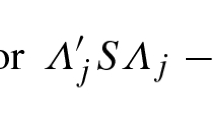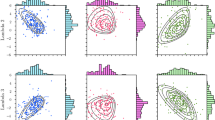Abstract
Factor analysis for nonnormally distributed variables is discussed in this paper. The main difference between our approach and more traditional approaches is that not only second order cross-products (like covariances) are utilized, but also higher order cross-products. It turns out that under some conditions the parameters (factor loadings) can be uniquely determined. Two estimation procedures will be discussed. One method gives Best Generalized Least Squares (BGLS) estimates, but is computationally very heavy, in particular for large data sets. The other method is a least squares method which is computationally less heavy. In one example the two methods will be compared by using the bootstrap method. In another example real life data are analyzed.
Similar content being viewed by others
References
Aitchison, J. R., & Brown, J. A. C. (1957),The Lognormal Distribution. London: Cambridge University Press.
Barankin, E., & Gurland, J. (1951). On asymptotically normal efficient estimators: 1.University of California Publications in Statistics, 1, (6), 86–130.
Bentler, P. M. (1983a). Simultaneous equation systems as moment structure models: With an introduction to latent variable models.Journal of Econometrics, 22, 13–42.
Bentler, P. M. (1983b). Some contributions to efficient statistics in structural models: Specification and estimation of moment structures.Psychometrika, 48, 493–517.
Bentler, P. M., & Lee, S. Y. (1975). Some extensions of matrix calculus.General Systems, 20, 145–150.
Bentler, P. M., & Lee, S. Y. (1978). Matrix derivatives with chain rule and rules for simple, Hadamard, and Kronecker products.Journal of Mathematical Psychology, 17, 255–262.
Boomsma, A. (1983). On the robustness of LISREL (maximum likelihood estimation) against small sample size and non-normality. Unpublished doctoral dissertation, University of Groningen, Groningen.
Browne, M. W. (1974). Generalized least squares estimators in the analysis of covariance structures.South African Statistical Journal, 8, 1–24. (Reprinted in D. J. Aigner & A. S. Goldberger (Eds.),Latent Variables in Socio-Economic Models. Amsterdam: North Holland, 1977.)
Browne, M. W. (1982). Covariance structures. In D. M. Hawkins (Ed.),Topics in Applied Multivariate Analysis (pp. 72–141). London: Cambridge University Press.
Browne, M. W. (1984). Asymptotically distribution-free methods for the analysis of covariance structures.British Journal of Mathematical and Statistical Psychology, 37, 62–83.
Cook, M. B. (1951). Bivariatek-statistics and cumulants of their joint sampling distribution.Biometrika, 38, 179–195.
Cramér, H. (1946).Mathematical Methods of Statistics, Princeton, N J: Princeton University Press.
de Leeuw, J. (1983). Models and methods for the analysis of correlation coefficients.Journal of Econometrics, 22, 113–137.
Dunn, J. E. (1973). A note on a sufficiency condition for uniqueness of a restricted factor matrix.Psychometrika, 38, 141–143.
Du Toit, S. H. C. (1979). The Analysis of growth curves. Unpublished doctoral dissertation, University of South Africa, Pretoria.
Efron, B. (1979). The 1977 Rietz Lecture: Bootstrap methods: another look at the Jack-knife.The Annals of Statistics, 7, 1–26.
Ferguson, T. S. (1958). A method of generating best asymptotically normal estimates with application to the estimation of bacterial densities.Annals of Mathematical Statistics, 29, 1046–1062.
Graham, A. (1981).Kronecker products and matrix calculus with applications. Chichester: Ells Horwood.
Howe, W. G. (1955).Some contributions to factor analysis (Report No. ORNL-1919). Oak Ridge, TN: Oak Ridge National Laboratory.
Hsu, P. L. (1949). The limiting distribution of functions of sample means and application to testing hypotheses.Proceedings of the First Berkeley Symposium in Mathematical Statistics and Probability (pp. 359–402). Berkeley.
Isserlis, D. Sc. (1916). On certain probable errors and correlation coefficients of multiple frequency distributions with skew regression.Biometrika, 11, 185–190.
Jennrich, R. I. (1978). Rotational equivalence of factor loading matrices with specified values.Psychometrika, 43, 421–426.
Johnson, N. L., & Kotz, S. (1970).Continuous Univariate Distribution—I. Boston: Houghton Mifflin.
Jöreskog, K. G. (1967). Some contributions to maximum likelihood factor analysis.Psychometrika, 32, 443–482.
Jöreskog, K. G., & Goldberger, A. S. (1972). Factor analysis by generalized least squares.Psychometrika, 37, 243–260.
Jöreskog, K. G., & Sörbom, D. (1979).Advances in factor analysis and structural equation models. Cambridge, MA.: Abt.
Jöreskog, K. G., & Sörbom, D. (1981).Lisrel V Users Guide. Chicago: International Educational Resources.
Kagan, A. M., Linnik, Y. V., & Rao, C. R. (1973).Characterization problems in mathematical statistics. New York: John Wiley & Sons.
Kaplan, E. L. (1952). Tensor notation and the sampling cumulants ofk-statistics.Biometrika, 39, 319–323.
Kendall, M. G., & Stuart, A. (1977).The advanced theory of statistics, Volume 1. New York: Mac-Millan.
Lawley, D. N. (1940). The estimation of factor loadings by the method of maximum likelihood.Proceedings of the Royal Society of Edinburgh, 60, 64–82.
Layard, M. W. J. (1972). Large sample tests for the equality of two covariance matrices.Annals of Mathematical Statistics, 43, 123–141.
Layard, M. W. J. (1974). A Monte Carlo comparison of test of equality of covariance matrices.Biometrika, 16, 461–465.
McDonald, R. P., & Swaminathan, H. (1973). A simple matrix calculus with applications to multivariate analysis.General Systems, 18, 37–54.
Mooijaart, A., (1978).Latent Structure Models. Unpublished doctoral dissertation, Leiden University, Leiden.
Pearson, K., & Filon, L. N. G. (1898). Mathematical contributions to the theory of evolution: IV. On the probable error of frequency constants and on the influence of random selection of variation and correlation.Philosophical Transactions of the Royal Society of London (Series A),191, 229–311.
Rao, C. R. (1966). Characterization of the distribution of random variables in linear structural relations.Sankhya (Series A),28, 251–260.
Reiersøl, O. (1950). Identifiability of a linear relation between variables which are subject to error.Econometrika, 18, 375–389.
Steiger, J. H., & Browne, M. W. (1984). The comparison of interdependent correlations between optimal linear composities.Psychometrika, 49, 11–24.
Steiger, J. H., & Hakstian, A. R. (1982). The asymptotic distribution of elements of a correlation matrix: Theory and Application.British Journal of Mathematical and Statistical Psychology, 35, 208–215.
Steiger, J. H., & Hakstian, A. R. (1983). A historical note on the asymptotic distribution of correlations.British Journal of Mathematical and Statistical Psychology, 36, 157.
Swain, A. J. (1975). A class of factor analysis estimation procedures with common asymptotic sampling properties.Psychometrika, 40, 315–335.
Van Putten, C. M., & Commandeur, J. J. F. (1984).Structuur van leerkrachtuitspraken over sociaal-emotionele leerlingkenmerken in IBO, LBO en VBO/MLK [Structure of statements of teachers about social-emotional characteristics of pupils at schools for individual vocational education]. Leids Interdisciplinair Centrum voor Onderwijs Research (LICOR). Leiden: Rijksuniversiteit Leiden.
Author information
Authors and Affiliations
Additional information
This paper has partly been written while the author was a visiting scholar at the Department of Psychology, University of California, Los Angeles. He wants to thank Peter Bentler who made this stay at UCLA possible and for his valuable contributions to this paper. This research was supported by the Netherlands Organization for the Advancement of Pure Research (Z.W.O) under number R56-150 and by USPHS Grant DA01070.
Rights and permissions
About this article
Cite this article
Mooijaart, A. Factor analysis for non-normal variables. Psychometrika 50, 323–342 (1985). https://doi.org/10.1007/BF02294108
Received:
Revised:
Issue Date:
DOI: https://doi.org/10.1007/BF02294108




